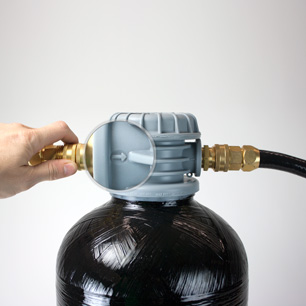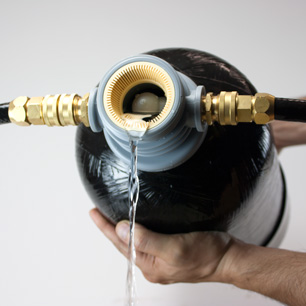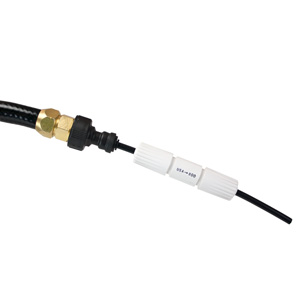Installing and Servicing the
Garden Hose Water Softener
Installation
Installation consists of simply attaching garden hoses to the inlet and outlet ends of the softener. See the directional arrows. The double swiveled female connector should be attached to the inlet if you are hooking to a garden hose. (Leave it off if you're hooking to a washer hose.)
The softener resin is already in the tank and the unit is ready to use. The resin is fully charged and will process some 10,000 grains of hardness before regeneration is needed. (For example, if your water is 10 grains per gallon hard, the unit will soften around 1,000 gallons of water before regeneration with salt is needed.)
When your hoses are in place, turn on the water at a low flow rate and allow the softener to fill slowly. After the softener tank fills, soft water will issue from the outlet hose. The first water out will be cloudy. Allow the softened water to run until it runs clear before using the water. To avoid resin loss, keep your flow rate very low until the resin is thoroughly saturated.
Operation
The unit can be turned on or off from either the inlet or outlet side. It will bear standard residential water pressure. Recommended maximum service flow rate is 3 gallons per minute. Water quality will suffer if you exceed this. Best results are achieved at no more than 2 gallons per minute.
Testing
To determine when the softener needs to be regenerated, test occasionally with the test strips included. The new softener will test at or near 0 grains on the strip. Regeneration should be done when the hardness level reaches 4 or 5 grains, or earlier if extremely soft water is required. (For most uses, anything below 5 or 6 grains will be acceptable.)
Regeneration
The softener's ability to soften water is renewed by exposure to salt. The degree to which the softener's resin is renewed depends on how much salt it is used (see note below) and how well you follow these instructions:
-
Turn off the water and let off the pressure by removing any hose attachments. Screw the top cap off of the softener. (Remove the top cap, not the entire head. See picture.) Tip the softener carefully to pour out most of the water from the top of the media bed. Be careful not to pour out the softener resin.
-
Two pounds of salt will bring the resin back to around 2/3 of its original 10,000 grain capacity. Common table salt works fine. Adding another pound, for a total of three, will get you to about 80% of the original capacity. Adding still more salt will get even closer to the original strength, but regenerating with more than 3 pounds is not worth the trouble.
The most economical practice is to use two pounds: you'll get more performance for your salt but you'll have to regenerate a bit more often than you would if you use three.
Pour two pounds of salt into the open top directly onto the top of the media bed. When the salt is in the softener, pour in a cup or two of water to rinse the cap area, replace the cap on the tank, and let the unit sit for at least five minutes.
-
Now, attach the flow restrictor to the end of the hose to perform the “brine rinse.” (Or if you prefer, attach the restrictor to the outlet fitting of the softener.)
With the restrictor in place, run water through the unit. The restrictor will cut the water flow through the unit to about 1/4 gallon per minute, allowing a slow, thorough rinsing of the resin with the brine solution in the tank.
Allow ten minutes for the rinse. Don't cut the “brine rinse” phase short.
After the 10 minute rinse, turn off the water, remove the flow restrictor and run water at half your faucet speed for about 3 minutes to give the softener a rapid rinse.
The softener is now ready for action.
Maintenance
Backwashing the softener is the only maintenance necessary, and needs to be done only a couple of times per year. It's best to do it prior to the regeneration process described above.
-
To backwash the softener, simply move the inlet hose to the out port of the softener and run water at about one gallon per minute backward through the unit. Be careful. If you run water too fast you can wash resin out of the tank.
A backwash of three or four minutes a couple of times a year is plenty.
Site Index
Filtration Systems
- Aeration for Iron & Sulfide
- Backwashing Filters
(whole house & well units)
- Chlorine & Chemical Injectors
- Countertop Water Filters
- Emergency Filters
- Garden Hose Filters
- Reverse Osmosis, Residential
- Reverse Osmosis, Commercial
- Shower Filters
- Specialty Filters
- Ultraviolet Systems
- Undersink Filters
- Water Softeners
- Whole House Filters
Cartridges
Parts
- Replacement Parts
- Faucets
- Filter Media
- Fittings
- Housings
- O-rings
- Pumps
- Pura UV
- R.O. Parts
- R.O. Tanks
- R.O. Booster Pump
- VIQUA UV


